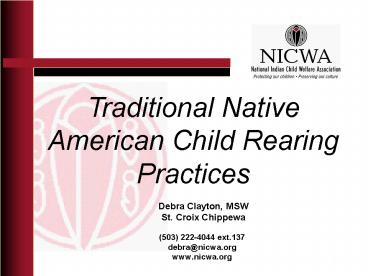Traditional Native American Child Rearing Practices - PowerPoint PPT Presentation
1 / 14
Title:
Traditional Native American Child Rearing Practices
Description:
Traditional Native American ... Adult American Indians who were placed with Non-Indian Families as Children The issue of the adult Indian ... traditions, and language ... – PowerPoint PPT presentation
Number of Views:902
Avg rating:3.0/5.0
Title: Traditional Native American Child Rearing Practices
1
Traditional Native American Child Rearing
Practices
Debra Clayton, MSW St. Croix Chippewa
(503) 222-4044 ext.137 debra_at_nicwa.org
www.nicwa.org
2
NICWA Mission
- NICWA is dedicated to the well-being of American
Indian/Alaska Native (AI/AN) children and
families.
3
NICWA Vision
Split Feathers Research Adult American Indians
who were placed with Non-Indian Families as
Children
- Study by Carol Locust, PhD. Published in
Pathways Practice Digest, January 1999. - Split Feathers Syndrome psychological, social,
and emotional disability and distress related
directly to expatriation (foster care adoption)
as children.
4
Importance of this study
- The issue of the adult Indian who was placed in a
non-Indian home as a child had not been
addressed. - Every child placed in a non-Indian home for
foster care, or adoption was at great risk for
long-term psychological damage as adults. - At risk statement comes from congressional
hearings pursuant to ICWA. - Lack of sufficient data.
5
Summary of Findings
- All but 1 (of 20) had moderate to severe
psychological problems. - All 20 respondents indicated that they had
difficulty with intimate relationships. Feeling
alone, failed marriages, no close friends. - 13 of 20 responses analyzed indicated that the
respondents had abused alcohol and/or drugs. - ALL 20 said they knew they were different before
they were elementary school age, all 20
experienced negative feelings because of being
different. - All 20 felt they were average or above in
intelligence, half had spent time in education
remedial programs, 5 were labeled learning
disabled, 2 were classified as slow learners. All
of them had failed at least one grade. - 5 of the 20 completed high school, 15 went on to
military school, 3 were in correctional
institutions, 4 married. - NONE of them described themselves as successes.
6
Issues faced by Split Feathers
- Loss of Indian Identity
- Loss of family, culture, heritage, language,
spiritual beliefs, tribal affiliation, and tribal
ceremonial experiences - Anguish from growing up different
- Having to experience discrimination from the
dominant culture based on their physical
appearance - Cognitive differences, a term derived from the
descriptions of thinking differently, being
different in my mind, not being able to learn
like everyone else
7
Why is Relative Placement Important?
- To keep culture, traditions, and language from
getting lost. - Children are confident and have an identity.
- Families feel connected, supported, and together.
They dont feel torn or have missing links. - Young children are taught traditional coping
skills, family roles, and community. - Children are taught that healing and recovery are
possible.
8
Natural Protective Factors
- AI/AN children are viewed as gifts from the
Creator, children are cared for by a whole
community (family, extended family, clans) versus
just the parents doing all the work. - Elders are highly regarded and trusted to teach
the young and be helpers in their care and
raising. - Parents are supported and encouraged, and those
who did not care for their children properly were
ridiculed into compliance. - Cultural events such as naming ceremonies.
- Community gatherings, dances, spiritual events
- sweats, vision quests, canoe journey.
- Story telling as a teaching tool.
9
Psychological Parent Model
10
Extended Family Model
11
Permanency Planning Philosophy
- The primary right and responsibility for child
rearing lies with the parent and/or extended
family. - Permanence can only be said to exist judged on
the perception of the child. - The best permanent plan is for the Indian child
to grow up in his/her own family, or extended
family. - Parents with substance abuse problems have the
right to services that recognize addiction as a
disease, to have a relationship with their child
despite their disease, and to receive treatment
that will enable them to be a permanent resource
for their child. - Identifiable case plans that state goals and how
those goals are to be achieved, subject to
review, are essential for permanence.
12
ALL My Relations Video
- All My Relations Impacts of the Indian Child
Welfare Act of Foster Parenting - (Video Viewing 45 minutes)
- By WA State DSHS
- Group Discussion
- 15 minutes
13
For More Information
- To learn more, visit www.nicwa.org or call
- (503) 222-4044
- Debra Clayton, MSW
- debra_at_nicwa.org
14
www.nicwa.org
National Indian Child Welfare Association

